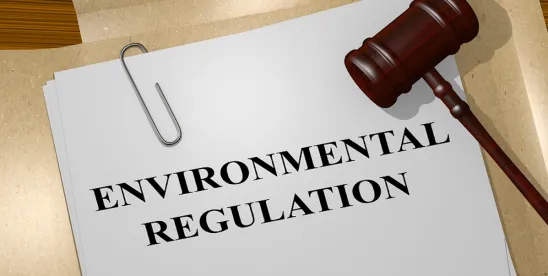The final days of the U.S. Supreme Court’s 2023 term saw the release of several decisions that may – or may not, depending on one’s perspective and desired strategy – hold significant implications for administrative law practice as well as the interpretation and enforcement of environmental and natural resource law (among other areas of law). These include Loper Bright Enterprises v. Raimondo, Relentless, Inc. v. Department of Commerce, Securities and Exchange Commission v. Jarkesy, and Corner Post, Inc. v. Board of Governors of the Federal Reserve System, along with Ohio. v. Environmental Protection Agency (in which B&D successfully represented a petitioner in securing stay of the U.S. Environmental Protection Agency’s (EPA) Good Neighbor Rule). Major media outlets have covered each case and its potential ramifications at a high level. B&D provided summaries of these cases earlier this year in our Litigation Look Ahead series.
While each case may hold unique implications on its own, in this overview we highlight some of the potential impacts the cases could have when taken collectively. While the long-term impacts are unknown and may play out in various ways depending on the statute, venue, and case in question, these decisions and others in the 2022 and 2023 Supreme Court terms have continued a trend by the Court towards deregulation at the federal government level and consolidation of authority in the judicial branch to adjudicate regulatory questions. This poses both challenges and opportunities for the regulated community.
Each regulated entity should reevaluate, in a holistic manner, its regulatory and litigation strategy – including active or recently-concluded rulemaking challenges, enforcement actions, and litigation – as these recent cases may present new threats and opportunities. U.S. federal and state regulators – as well as environmental and other NGOS – are no doubt doing the same.
Key Potential Implications
- Although the Supreme Court has not expressly relied on Chevron in any case since 2016, Chevron has been a controlling principle in lower courts. Depending on the venue, issue, and case, impacts of the Loper Bright decision could thus be more gradual and muted or immediate and significant. For instance, the most recent Supreme Court order requires the D.C. Court of Appeals to revisit a victory for a renewable fuel developer following the Loper Bright decision.
- Loper Bright invalidates Chevron based on a separation of powers analysis that puts a premium on judicial decision-making over agency interpretations. It provides an opportunity to challenge regulations that did not exist before. Although courts will likely consider an agency’s interpretation of technical language in a statute if the agency’s area of expertise can shed light on the meaning of the term (while no longer being required to defer to an agency’s interpretation).
- As we consider the impacts of overturning Chevron, become familiar with Skidmore deference from the 1944 pre-Chevron decision. In essence, Skidmore provides that judicial deference to an agency’s interpretation depends on its “power to persuade.” Chief Justice Roberts refers to Skidmore five times in his Loper Bright opinion. The U.S. government may attempt to use Skidmore in place of Chevron arguments.
- The Loper Bright decision will significantly impact agencies’ ability to adopt novel interpretations of statutes. The U.S. Fish and Wildlife Services and National Marine Fisheries Service, for example, routinely relied on Chevron to promulgate far-reaching regulations under both the Endangered Species Act and Marine Mammal Protection Act.
- There will likely be many cases where the statutory language is clear enough that judges decline to find the ambiguity petitioners seek. Even so, some key questions of statutory interpretation may be relitigated. Certain Clean Air Act (CAA), Clean Water Act (CWA), Endangered Species Act (ESA), and Resource Conservation and Recovery Act (RCRA) rules, as well as any recent major environmental and energy cases such as, for example, those dealing with SEC climate change disclosure rules and electric vehicles, are among those most likely to be relitigated.
- Judges may differ in their interpretations of ambiguous statutes, which could cause more conflicting interpretations of the same statutory provisions and necessitate appellate or Supreme Court intervention to resolve splits by lower courts.
- Industry and trade associations should weigh which issues to relitigate. There may be a disincentive to relitigate issues if industry has already invested significantly in adoption and implementation. In Loper Bright, the Supreme Court made it clear that the decision is for the future. However, Corner Post provides an opportunity to challenge regulations beyond the Administrative Procedure Act (APA) six-year statute of limitations in some cases.
- EPA will continue (and likely increase its actions) to set policy by interpreting data and setting policy in ways that are more difficult to subject to judicial review. Companies will need to engage actively in situations where, even in the new Loper Bright landscape, opportunities for challenge are limited.
- Auer deference, a Supreme Court precedent dealing with how an agency interprets its own rules, was not discussed in the Loper Bright decision and remains available, particularly after the Supreme Court decision in Kisor v. Wilkie. This will have implications for many rulemaking, compliance, and enforcement actions. Applying Auer, a court may be more inclined to defer to an agency’s interpretation of ambiguities in its own regulations than its interpretation of ambiguities in a law adopted by Congress. For example, EPA has increasingly used its “reinterpretations” of old rules (like the Benzene Waste Operations NESHAP) in the enforcement context to achieve results it could not achieve by rule, or that would be difficult to do because it would need to go through the rulemaking process, cost-benefit analysis, and so forth.
- EPA and other agencies can utilize rulemaking by enforcement approach and evade APA rulemaking. Companies need to pay maximal attention to compliance with existing regulations to minimize the leverage that agencies have in the enforcement context. Questions of regulatory interpretations or challenges will also need to satisfy the statute under which they arise (CAA, CWA, RCRA, etc.), which may pose jurisdictional limitations.
- Nearly any time any litigant is litigating with the government concerning the interpretation of a statute, in any way, Loper Bright will be cited. Corner Post amplifies this by creating the possibility that an agency rulemaking could be challenged years down the line. Loper Bright may well be broader than just statutory issues, as it gives much detail and body to the APA.
- Watch state court/state statute analogs. The full impact of Loper Bright in state courts is unclear where requirements now exist that require deference to agency interpretations in favor of the strict separation of powers approach underlying Loper Bright.
- Loper Bright should be read consistent with West Virgina v. EPA, also written by Chief Justice Roberts, for the “major questions doctrine,” which still applies. To the extent challengers can frame their arguments as dealing with major questions which Congress did not specifically authorize an agency to regulate, the challenge is more likely to be successful.
- While on its face, Jarkesy only applies to SEC fraud claims heard before SEC administrative law judges, the implication of the case may be much broader and apply to more agencies. An option to challenge the authority of an agency to render penalties in administrative actions may now exist in some cases. If applied to EPA, it will raise practical issues such as whether there is an advantage to challenging or foregoing administrative action when the alternative may be federal court litigation. And, issues of when to push jury trials are complicated, particularly after the Err decision by the U.S. Court of Appeals for the Fifth Circuit providing for jury trials in Oil Pollution Act cases.
- Revisit and become familiar with “canons of interpretation” (also referred to as canons of construction). Under the revised doctrines in Loper Bright and other cases, courts that want to be in step with the U.S. Supreme Court will use such canons more to give meaning to statutory language.
- Corner Post creates a new pathway for regulated entities to challenge long-settled regulations. The decision opens the door to facial challenges to regulations, brought under the APA, when the regulation is first published or when a regulated entity first suffers a related “legal wrong” or “adverse affect” from final agency action, no matter the promulgation date, so long as the challenge is commenced within six years of the initial harm.
- Project development decisions likely not impacted by Loper Bright but may be by Corner Post. As one example of an area likely not impacted by the Loper Bright decision, individual project development decisions typically involve application of existing agency rules to specific facts rather than novel statutory interpretation. Corner Post, however, raises the prospect of delayed challenges to projects with long construction schedules that are not covered by a shorter statute of limitations than the general six-year period (e.g., FAST-41).
- Expect future Waters of the United States (WOTUS) rulemakings and even determinations regarding the scope of WOTUS in individual cases being driven much more by the text of the statute and Sackett than by scientific considerations. Courts were already moving in this direction, but Loper Bright will accelerate the trend.








 />i
/>i

